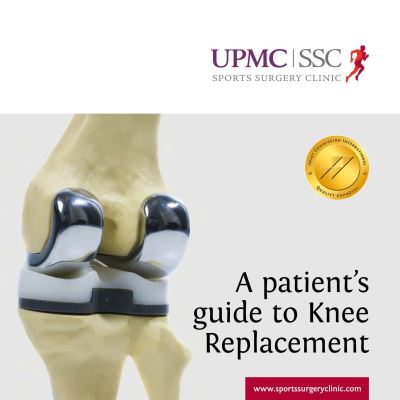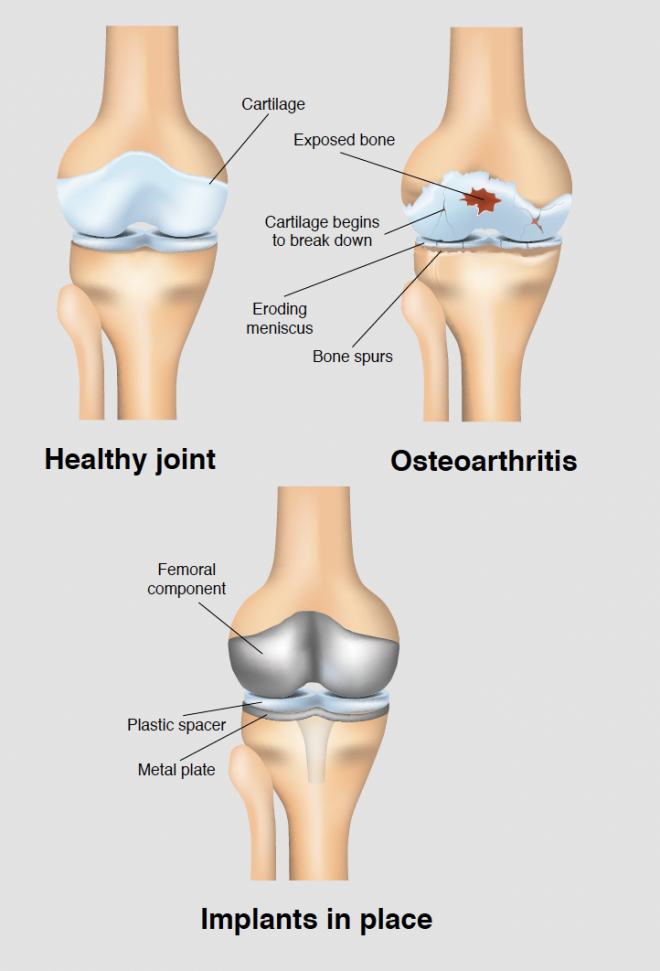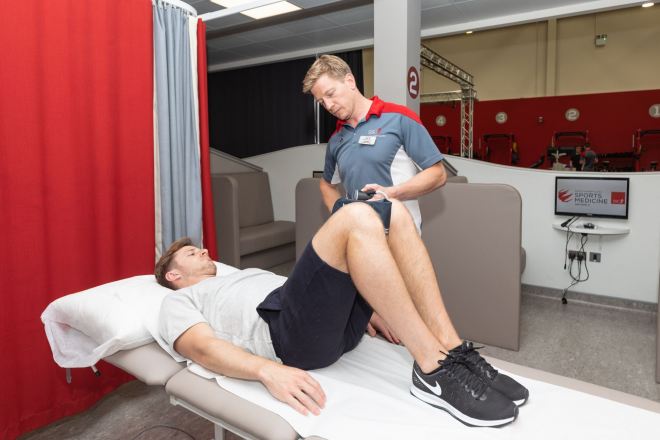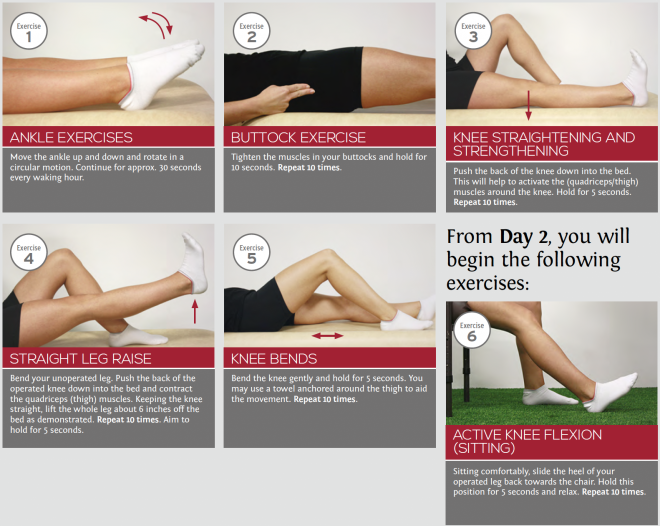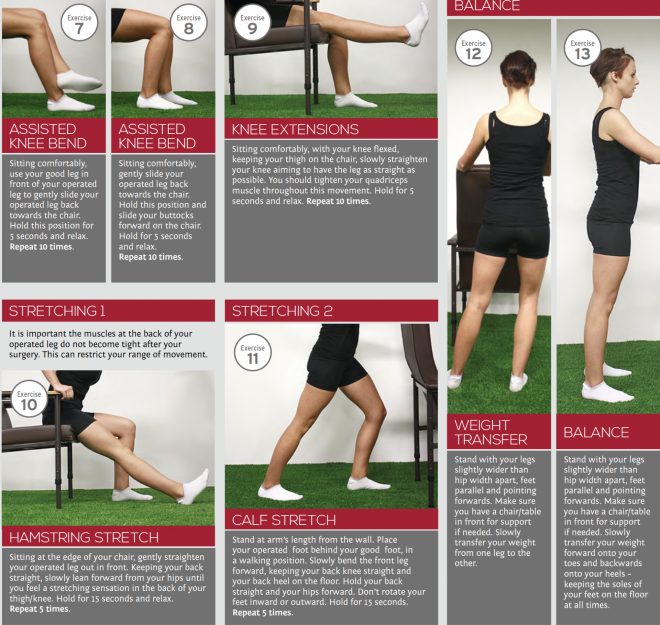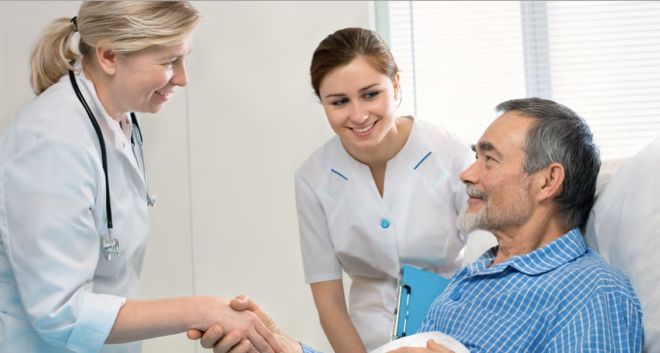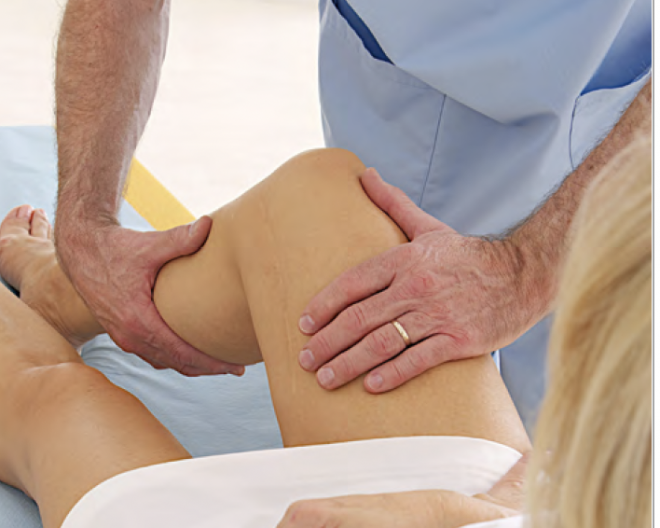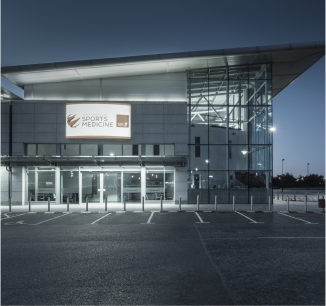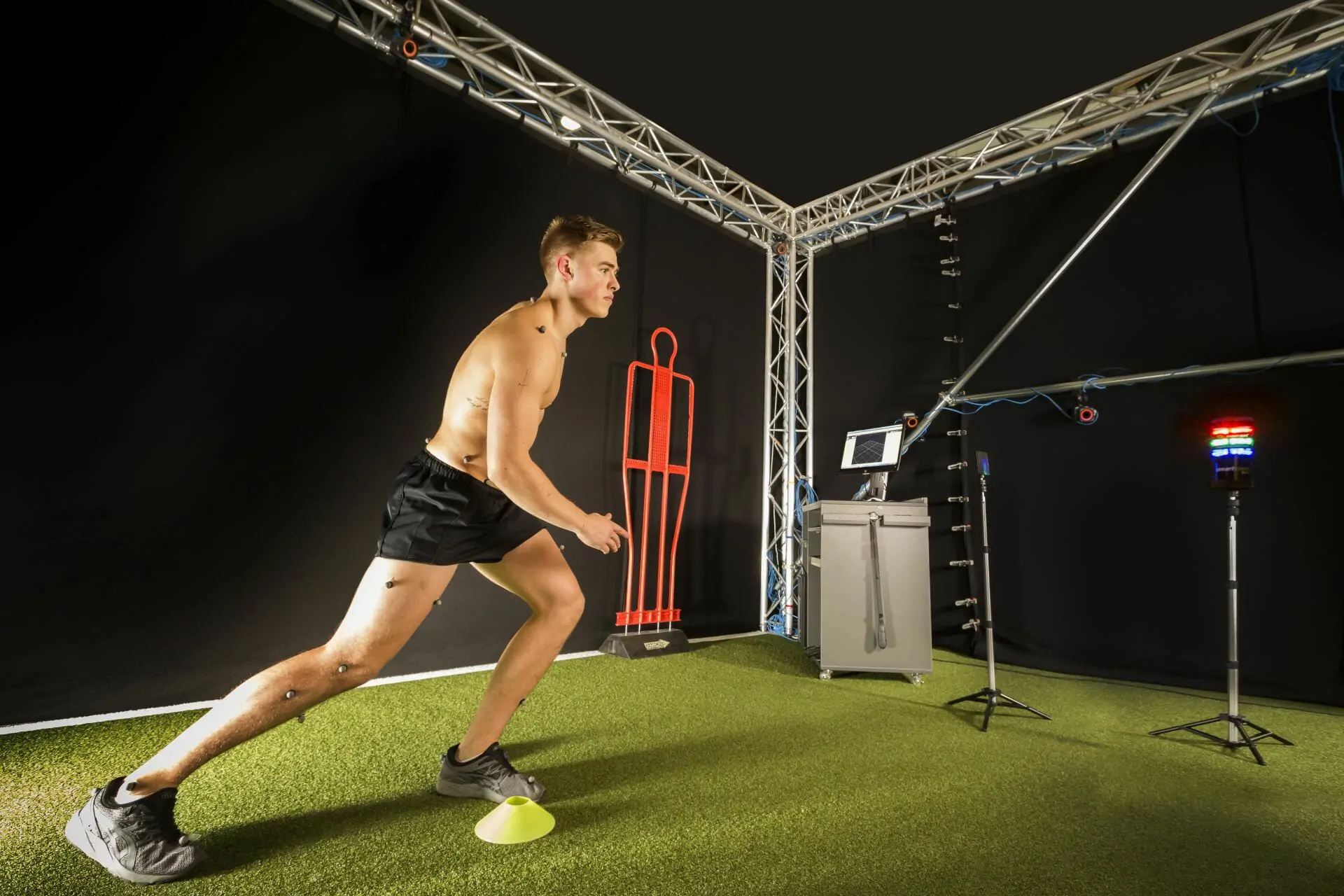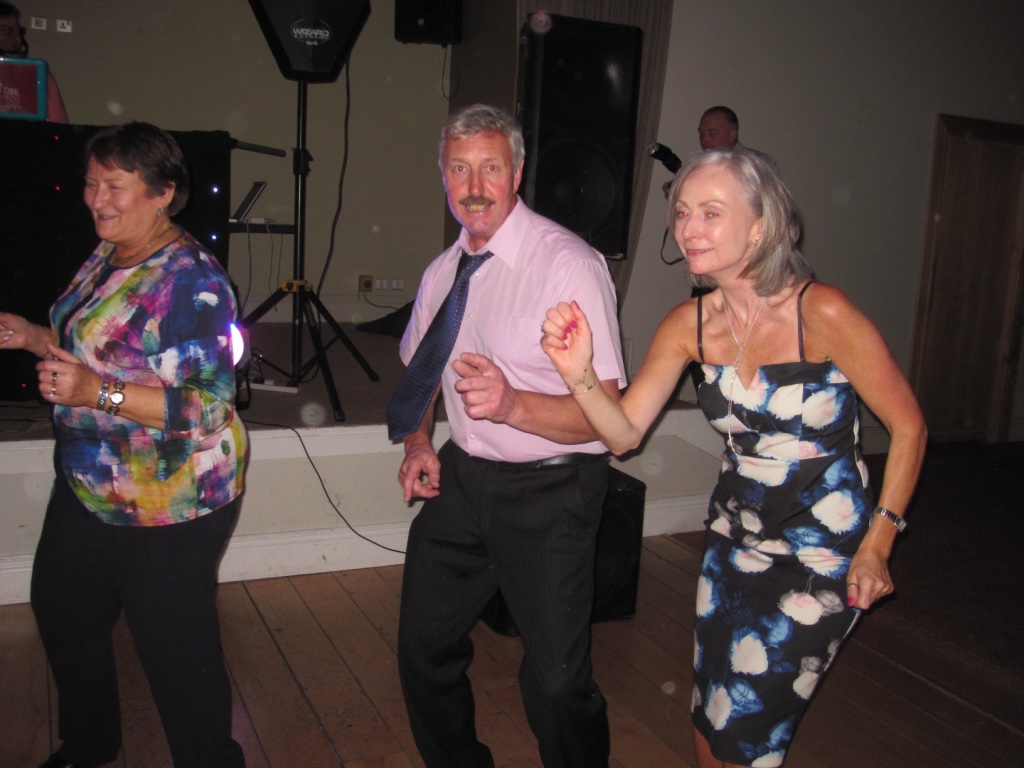Total Knee Replacement (TKR)
The most common reason for knee replacement surgery is Osteoarthritis. Osteoarthritis simply means that the protective cartilage of the knee has worn out, resulting in the thigh bone and shin bone rubbing together. As you know, this is very painful and stops you being able to move your knees as you once did.
At UPMC Sports Surgery Clinic, we understand the challenges of osteoarthritis, and we offer advanced solutions to help you regain mobility and alleviate pain.
If the degree of osteoarthritis is quite severe and debilitating, a Total Knee Arthroplasty is often the recommended form of treatment. This open procedure involves removing the damaged areas of cartilage loss, and replacing them with synthetic components (often metal), to recreate the joint surfaces. The inner surface of the patella may also be resurfaced if needed. An artificial “spacer” is inserted between the metal components to allow the new joint to glide smoothly and efficiently.
The most common reason for knee replacement surgery is Osteoarthritis. Osteoarthritis simply means that the protective cartilage of the knee has worn out, resulting in the thigh bone and shin bone rubbing together. As you know, this is very painful and stops you being able to move your knees as you once did.
All patients scheduled for joint surgery must attend the pre-assessment clinic (PAC) and are invited to attend 3-4 weeks before proposed surgery (following referral by their consultant).
This ensures that all test results are valid for admission and allow more time to resolve problems so surgery can be performed without delaying the planned surgery date. The PAC is a comprehensive medical assessment taking place to ensure patients are fit for surgery, therefore minimising risk and ensuring a speedy recovery, while avoiding cancellation and disappointment on the day. At the clinic you will be seen by both a nurse and a doctor.
To make sure you are fit for the operation and anaesthetic a number of tests will be carried out, they will include the following:
- Electrocardiogram (ECG) which is a non-invasive heart investigation.
- lDetailed patient history.
- Examination by medical doctor.
- Blood pressure and heart rate.
- Urinary sample to test for urinary tract infection (UTI) and diabetes.
- Methicillin resistant staphylococcus aureus (MRSA) screening. This includes swabs from nose and groin. This is a bacteria resistant to some antibiotics.
- lBlood tests.
- Blood type and screen. This is done in case we need to give a blood transfusion during or after your operation.
- Body mass index (BMI).
Please ensure that you bring the following with you on the day of PAC:
- All medication (in their original labelled containers) that you are currently taking. It is important that the medication is not repackaged into a weekly pill dispenser/pill box.
- Relevant X-rays, MRI, CT including any chest X-rays taken within the last three months or relevant joint
- X-rays taken within the last six months.
- Please bring address and phone number of your
- GP and any other consultant or specialist you are currently attending.
- Please bring any results or reports from any past ECG, ECHO, or angiograms.
- Please ensure that your first name and date of birth is as it appears on your birth certificate.
- The complete PAC visit will approximately take one hour.
Before your surgery it is important to maintain an active lifestyle so that the muscles around your knee stay strong. Research has shown that patients who complete an exercise program before their surgery have a quicker recovery than those who don’t.
Knowing what to expect, practicing drills on early post-operation management and exercising before your surgery will help you increase your confidence and ability to exercise after your operation.
At SSC we run weekly prehabilitation classes in our physiotherapy department gym. This class consists of an education section where you learn about your surgery and what to expect. We also give you exercises to help prepare your body in advance, and practice using your crutches so you can be confident after your surgery and during rehabilitation.
We explain in detail what you can expect from physiotherapy after your operation and give you some practical tips. We will answer any questions or concerns you have about your rehabilitation. To book your class please contact the SSC physiotherapy department on 01-526204
You will be admitted into SSC either the day before or morning of your operation. On admission, you will check in at the reception area and be asked to confirm your details for your medical file. A member of the admissions staff will accompany you to the Inpatient Ward where you will be greeted by the nursing staff. The nursing staff will show you to your bed and check your weight, height, temperature, blood pressure, pulse and respiratory rate. The nursing staff will also update and complete the nursing assessment that was started in PAC. You will also see other members of the team at this time. If you have any questions do not hesitate to ask a member of staff.
- If you take medication on a regular basis please bring this with you, in its original packaging, as we may use this while you are in SSC.
- Please remember to remove false nails/long term nail varnish before coming into SSC.
- lWe advise that you bring nightwear, a dressing gown, slippers (flat, closed heel slippers) or walking shoes, reading glasses and toiletries. You will also need some day wear for your discharge from the clinic.
- lWe advise that you do not bring valuables into the hospital with you. You may keep your wedding ring on (which will be covered with tape) when you go to theatre but this is the only jewellery you will be allowed.
- Your consultant will draw an arrow on your knee to indicate which one is being operated on.
- You cannot eat or drink anything for at least 4 hours before your operation, so you will usually be ‘Nil by Mouth’ from 12 midnight (for a morning operation) or 6am (for an afternoon operation). The nursing staff will remind you about this. This includes chewing gum.
- On the morning of your surgery you will be given a theatre gown to change into. You will be asked to remove nail polish, make up and jewellery, apart from a wedding band which can be taped over.
- You will be wearing one white stocking, which is called a TED stocking, on the opposite leg i.e. the leg you are not having your operation on. The stocking is applied to help improve the circulation in your legs and so reduce the risk of getting a blood clot. A stocking will be applied to your operation leg the day after your operation.
- The anaesthetist, who is the doctor that will be administering your anaesthetic, will talk to you before your operation. He / she will talk to you about your general health and any previous anaesthetics. He/she will check you lab tests and all other relevant tests and letters from other specialists. They will then advise you of the safest anaesthetic for you with regard to the operation you are having done.
For total hip/knee replacements:
- Spinal anaesthetics are the most commonly used anaesthetic. An injection is carefully placed in the lower back area, this causes your legs to become numb. They stay numb all the way through the surgery and come back to normal later. While you are in the operating theatre your Anaesthetist will give you other medication, which will relax and sedate you. You are very unlikely to hear or see any part of the surgery.
- General Anaesthetics are less commonly used for joint replacement surgery. However if your anaesthetist recommends that you have a general anaesthetic, you will receive medication via the intravenous cannula in your hand/arm, then you will drift off to sleep and wake up in the recovery room when the surgery is completed.
- enhance your recovery and to minimise the time spent in hospital you will be given various medications to treat pain. Your anaesthetist will prescribe medications which suit you. These will mostly be given to you to swallow in tablet form. You are encouraged to eat and to get back to normal as soon as possible.
- You will be taken to theatre on your bed. A nurse will accompany you to theatre. In the reception area the theatre staff will check your details and ask you several details such as when you last ate or drank and which knee is being operated on. This is all quite normal, as we like to check these details several times.
- From the reception area you will be wheeled into the anaesthetic room where you will have your anaesthetic. Once you have had your anaesthetic you will be transferred into the operating theatre.
- The duration of the operation is normally two hours but you will be off the ward longer than this because you will need time to have the anaesthetic before the operation and to recover after the operation.
- You will be wheeled from the operating theatre into the recovery room where you will be closely monitored by the nursing staff. The nurses will check that you are recovering from your anaesthetic by checking your blood pressure, pulse, breathing rate and so on. Once they have assessed that you are recovered enough you will be transferred back to the ward on your bed.
- You will have oxygen delivered either through a mask on over your nose and mouth or through a small double pronged tube which sits at the nasal passages and you have a bag of fluid running through a tube into one of your veins.
- A variety of medications are used post-op, many are oral medications. Despite being oral (given by mouth) they are strong enough to give good pain relief after surgery.
- There may be a drain based on one side of your wound to drain any excess blood or fluid from your wound that could cause delayed healing of the wound. The excess blood/fluid is drained into a collection bottle attached to the drain.
- You will have a bulky/thick bandage on your operated leg from the middle of your thigh to the middle of your calf. This bandage will stay in place for about 24 hours after your surgery.
- Once you are back in the ward the nurses will continue to monitor you. You will have your blood pressure, pulse etc., checked regularly.
- You will start taking sips of water as soon as you come back to the ward and gradually you will be allowed to eat and drink as normal. Many people feel sick after the surgery and this can be due to the anaesthetic and medication that you were given during the operation.
Once you are eating and drinking again the drip will be taken away. This is usually about 24 hours after the operation.
- If you need to pass water or have your bowels opened then the nurse will assist you in using a bedpan, as you will not be able to walk to the bathroom just yet.
- Starting from the night of your operation you may be given an injection into your stomach area. This will be given to you once a day for 3 days after your operation. This is given to help keep your blood slightly thin and help reduce the risk of developing clots.
- You will have foot pumps attached to both feet to aid circulation. These foot pumps cause a light squeeze at the bottom of your feet which in turn aid the circulation in your calves. The foot pumps are usually removed during the day once you are mobilising but should be worn at night.
The length of time you will remain in the hospital depends on how quickly you recover. This section outlines the stages you have to complete before you go home. Most people achieve these stages within 2-5 days of having the operation.
Stage 1 (the first day after your operation)
- The nursing staff will help you to have a wash in bed, as you will not have been out of bed yet.
- The physiotherapist, who will aim to get you out of bed, sitting in a chair and taking several steps with crutches, will visit you. The physiotherapist will remind you of the exercises to do.
- lThe dressing on your operated knee will be reduced and if present, the drain removed.
- A TED stocking will be applied to the operated leg.
Stage 2
- The physiotherapist will continue to assess how you are doing and help you to progress with your exercises and mobility.
- You will have a blood sample taken to check your blood count.
- If you have not had an X-ray in the recovery room then you will have an X-ray taken of your knee in the X-ray department. A member of staff will take you to the
- X-ray department.
Stage 3
- You will be walking with crutches under guidance from the physiotherapist.
- Your prescription will be arranged by the doctor.
- The physiotherapist will practice the stairs with you.
- Transport arrangements will be finalised. You will be asked to arrange for a relative or friend or friend to collect you by car.
Stage 4
- You will be discharged home. The nursing staff will go through with you the prescription that you can fill at any pharmacy. If you have any questions with your medicines then please ask the nurses who will be able to help you. Do not forget to take your walking aids with you.
- You will be sent an appointment by your consultants secretary with the date of your follow up outpatient appointment on it, usually for 6-8 weeks after you go home.
Please note that prescriptions cannot be filled from the pharmacy in SSC.
- Comfortable but supportive footwear, e.g. laced or velcro flat shoes or slippers with a closed heel. Ensure these are not very tight fitting as your ankle/foot may swell up after surgery.
- shorts, tracksuit bottoms or loose pyjama bottoms
You will be seen by a physiotherapist from the first day after your operation who will:
- help you with bed transfers
- teach you how to walk with crutches (or a Zimmer frame in some cases)
- guide you through an exercise program
- practice stairs with you
You will be allowed to sit out on a chair if you can tolerate it on the day after the operation.
You will be able to get up and walk from the first day after the operation and generally can put as much weight down through the operative limb as is comfortable (unless otherwise advised by your surgeon). You will be required to use two elbow crutches.
You will be required to climb the stairs with crutches before being discharged from hospital.
The physiotherapist will work with you in hospital until you are comfortable transferring to and from a bed and chair, are confident performing your home exercises and can mobilise safely with your crutches on the flat and on stairs.
It is important to continue your exercise program regularly, as directed by your physiotherapist, on a regular basis post-op.
In order to progress on with your rehabilitation we recommend that you organise an appointment with a chartered physiotherapist in an out-patient setting within about 3-5 days of your discharge from hospital. You can attend SSC for physiotherapy or can make an appointment with a physiotherapist in your area. On discharge from SSC you will receive a referral letter and rehabilitation protocol to give it to your out-patient physiotherapist. This will inform the physiotherapist of your surgery and give guidelines for your short and long term rehabilitation. It is likely that you will require follow up physiotherapy for several months after your operation.
The majority of patients who have knee replacement surgery go home from SSC, however some patients feel that they need further care in convalescence. If you feel that you need convalescence following your knee replacement you will need to arrange this yourself with a private rehabilitation unit before coming into SSC.
- Painkillers and reduced mobility can make you constipated therefore it is important that you drink fluids while in hospital and when you get home. The recommended amount to drink daily is 2 litres, which is about 8 glasses. Water is one of the best things that you can take. The nursing staff can give you some mild laxatives if you need them whilst you are in hospital and you may also be prescribed some to take home with you.
- We advise that you keep the TED stockings on for 6 weeks after your operation provided that you have someone to help you take them off at least once a week. The reason for this is so that you can wash and moisturise your legs, as the stockings tend to dry the skin on your legs quite quickly.
- l you have staples/stitches in your knee wound these will be removed from your wound between 10-12 days after your operation. Time frame may vary depending on individual consultant who will advise you on this.
- It is normal for your leg/knee to be quite bruised after the operation. This will fade in time.
- You should not undertake any long haul flights between for a period of 6 to 12 weeks after your operation as you are at increased risk of blood clot in your leg veins. Your consultant will advise you on this.
- The leg takes time to adapt to the knee replacement and it is quite common to experience discomfort around the knee for up to 6 months after the surgery. This is not as painful as the arthritis you had and is usually relieved by rest or a mild pain killer. Some patients describe a feeling of numbness around the knee, where the nerves, which are cut during the operation, do not re-join. This does not affect the strength of the knee at all. Not all these events are experienced by every patient but if they happen to you they are part of the normal recovery from the operation.
- Individual consultant follow up appointment times differ. You will be advised accordingly.
- Most patients find it too uncomfortable to kneel on their knee replacement and you are not encouraged to kneel regularly as the scar can be tender. Occasional kneeling (once or twice a week) for short periods is all right if you can tolerate it but only after your 6 weeks outpatient appointment after the operation.
Download brochure through this link Patients Guide to Knee Replacement Brochure
